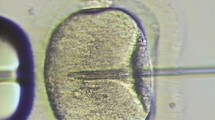Summary
The precise origin of the supernumerary chromosome can be defined in the majority of trisomy 21 cases. This is achieved by evaluating the chromosome 21 short arm polymorphism and analysing restriction fragment length polymorphisms (RFLPs) of multiple chromosome 21 loci. We report a study on 37 Italian families with Down's syndrome. In 35 cases (94.6%) both the parental and the meiotic stage of non-disjunction could be established. Knowledge of the origin of the extra chromosome 21 is a pre-requisite for investigations of genetic or environmental factors that may affect the meiotic process.
Similar content being viewed by others
References
Antonarakis SE, Kittur SM, Metaxotou C, Watkins PC, Patel AS (1985) Analysis of DNA haplotypes suggests a genetic predisposition to trisomy 21 associated with DNA sequences on chromosome 21. Proc Natl Acad Sci USA 78:3360–3364
Antonarakis SE, Chakravarti A, Warren AC, Slaugenhaupt S, Warren AC, Wong C, Halloran SL, Metaxotou C (1987) Reduced recombination rate in chromosomes 21 that have undergone nondisjunction. Cold Spring Harbor Symp Quant Biol 51:185–190
Aymé S, Mattei MG, Mikkelsen M, Aagensen L, Grinsted J, Nevin N, Dagna Bricarelli F, Arslanian A, Pierluigi M, Strigini P, Lungarotti S, Calabro A, Mariotti G, Baccichetti C, Artifoni L, Dallapiccola B (1986) Factors involved in chromosomal non-disjunction: a European Collaborative Study. 7th International Congress of Human Genetics, Berlin, 1986
Caspersson T, Zech L, Johansson C, Modest EJ (1970) Identification of human chromosomes by DNA binding fluorescent agents. Chromosoma 30:215–227
Davies KE, Harper K, Bonthron D, Krumlauf R, Polkey A, Pembrey ME, Williamson R (1984) Use of chromosome 21 cloned DNA probe for the analysis of non-disjunction in Down syndrome. Hum Genet 66:54–56
Del Mazo J, Perez Castillo A, Abrisqueta JA (1982) Trisomy 21: origin of non-disjunction. Hum Genet 62:316–320
Dellarco V, Voytek PE, Hollaender A (eds) (1985) Aneuploidy: etiology and mechanisms, vol 36. Plenum Press, New York
Frateschi M, Arslanian A, Pierluigi M, Ferro Ma, Gessaga M, Coviello DA, Strigini P, Dagna Bricarelli F (1984) Origine parentale del cromosoma 21 sovrannumerario in 267 soggetti con sindrome di Down. Relazione tra non-disginuzione ed etá dei genitori. In: Dagna Bricarelli F, Inglese C, Moretti A, Rasore Quartino A (eds) Sindrome di Down. Ce Pi M, Genova, pp 79–93
Goldgaber D, Lerman MI, McBride OW, Saffiotti U, Gajdusek DC (1987) Characterization and chromosomal localization of a cDNA encoding brain amyloid of Alzheimer's disease. Science 235:877–880
Hook EB (1985) The impact of aneuploidy upon public health: mortality and morbidity associated with human chromsomes abnormalities. In: Dellarco V, Voytek PE, Hollaender A (eds) Aneuploidy: etiology and mechanisms, vol 36. Plenum Press, New York, pp 7–33
Mikkelsen M, Poulsen H, Grinsted J, Lange A (1980) Non-disjunction in trisomy 21: study of chromosomal heteromorphism in 110 families. Ann Hum Genet 44:17–28
Quax-Jeuken J, Quax W, Van Rens G, Meera Khan P, Bloemendaal H (1985) Assignment of the human 127-1 gene (CRYA1) to chromosome 21. (8th International Workshop on Human Gene Mapping). Cytogenet Cell Genet 40:727–728
Sacchi N, Gusella JF, Perroni L, Dagna Bricarelli F, Papas TS (1988) Lack of evidence for association of meiotic non-disjunction with particular DNA haplotypes on chromosome 21. Proc Natl Acad Sci USA (in press)
Tanzi RE, Gusella JF, Watkins PC, Bruns GAP, Gail AP, St George-Hyslop P, Van Keuren ML, Patterson D, Pagan S, Kurnit DM, Neve RL (1987) Amyloid β-protein gene cDNA, mRNA distribution and genetic linkage near the Alzheimer locus. Science 235:880–884
Tippet P, Kaplan JC (1985) Report of the committee on the genetic constitution of chromosome 20, 21, 22. (8th International Workshop on Human Gene Mapping) Cytogenet Cell Genet 40:269–295
Van Keuren ML, Watkins PC, Drabkin HA, Jabs EW, Gusella JF, Patterson D (1986) Regional localization of DNA sequences of chromosome 21 using somatic cell hybrids. Am J Hum Genet 38: 793–804
Watkins PC, Tanzi RE, Gibbons KT, Tricoli JV, Landes G, Eddy R, Shows TB, Gusella JF (1985) Isolation of polymorphic DNA segments from human chromosome 21. Nucleic Acid Res 13:6075–6088
Watson DK, McWilliams-Smith MJ, Nunn MF, Duesberg PH, O'Brien SJ, Papas TS (1985) The ets sequence from the trasforming gene of avian erythroblastosis virus, E26, has unique domains on human chromosomes 11 and 21: both loci are transcriptionally active. Proc Natl Acad Sci USA 82:7294–7298
Author information
Authors and Affiliations
Rights and permissions
About this article
Cite this article
Bricarelli, F.D., Pierluigi, M., Perroni, L. et al. High efficiency in the attribution of parental origin of non-disjunction in trisomy 21 by both cytogenetic and molecular polymorphisms. Hum Genet 79, 124–127 (1988). https://doi.org/10.1007/BF00280549
Received:
Issue Date:
DOI: https://doi.org/10.1007/BF00280549




